As competition intensifies, the stakes for Black Friday (BFCM) have never been higher. With 2024 online sales expected to reach approximately $10 billion—building on 2023’s $9.8 billion, which saw a 7.5% increase—retailers must harness the power of AI to stay ahead. Global online sales growth is also on the rise, with $70.9 billion reported last year, reflecting an 8% year-over-year surge. This article provides retail executives with unique, data-driven AI strategies that optimize customer experience, pricing, and inventory management. Here, you’ll find actionable insights that go beyond the typical advice, ensuring your brand’s competitive edge in this crucial sales period.
Strategic AI utilization for BFCM dominance: The process
Step 1: Predictive analytics for BFCM inventory management
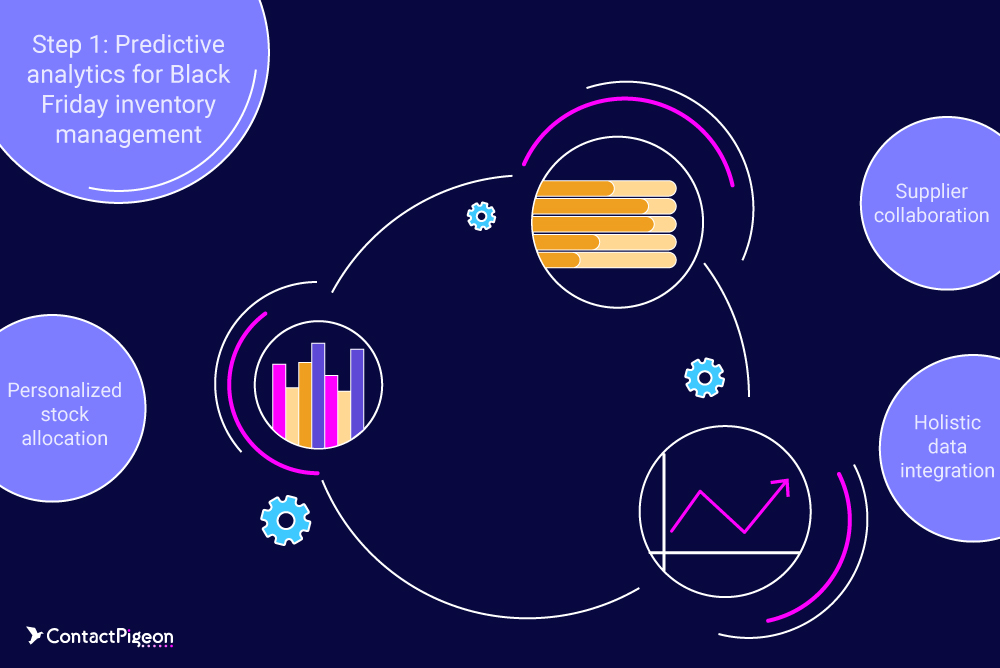
What it is: Predictive analytics uses AI to forecast product demand by analyzing historical data, market trends, and external factors. This ensures optimal inventory levels, preventing stockouts and overstock during the intense BFCM shopping period.
- Holistic data integration: Combine real-time data from social media trends, local events, and even weather forecasts to anticipate demand spikes during BFCM.
- Example: Predict increased winter apparel sales due to an early cold snap.
- Personalized stock allocation: Tailor inventory distribution based on local buying patterns, ensuring the right products are available in the right locations.
- Example: Stock urban stores with tech gadgets and suburban stores with household items to match regional demand during Black Friday and Cyber Monday.
- Supplier collaboration: Share AI-driven insights with suppliers to optimize production and delivery schedules. This helps maintain a lean, responsive supply chain, crucial during the BFCM rush.
- Example: Adjust order quantities and timing based on predicted demand spikes, ensuring timely restocking.
Opinion leaders to follow:
- Andrew Ng: AI expert and advocate for its application in retail operations.
- Kate Crawford: Researcher focused on AI’s broader social implications, including supply chain ethics.
Companies to watch:
- Zara: Masters of AI-driven inventory management.
- Walmart: Leveraging predictive analytics for efficient supply chain management.
How a retail CDP can assist with BFCM Inventory Management: A CDP tailors inventory distribution by analyzing customer segmentation data, ensuring that stores are stocked with products that match the preferences of their local customer base. This approach can increase sales by up to 20% during BFCM, as reported by Deloitte.
Step 2: Dynamic AI-driven BFCM pricing strategies
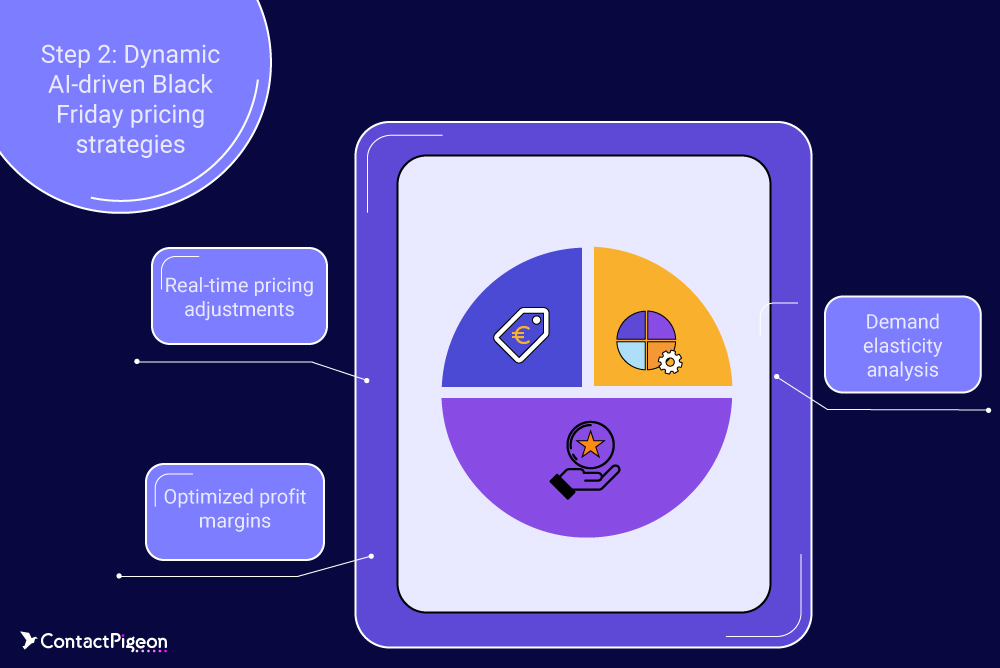
What it is: Dynamic AI-driven Black Friday pricing strategies involve using artificial intelligence to automatically adjust prices in real time based on factors such as market demand, competitor pricing, and customer behavior. This approach ensures optimal pricing, maximizing both sales volume and profit margins during the high-pressure BFCM period.
- Real-time pricing adjustments: Utilize AI to adjust prices in real time based on market demand, competitor pricing, and other variables.
- Example: Automatically lower prices to match competitors during Black Friday to stay competitive.
- Optimized profit margins: Balance competitive pricing with profitability by analyzing customer willingness to pay.
- Example: Identify premium segments willing to pay more, maximizing profit margins on high-demand items.
- Demand elasticity analysis: Use AI to understand demand elasticity and set prices that maximize revenue.
- Example: Increase prices slightly for inelastic products where demand remains stable despite higher prices.
Opinion leaders to follow:
- Stephan Liozu: Pricing innovation expert and founder of Value Innoruption Advisors.
- Rafi Mohammed: Author of “The 1% Windfall,” which emphasizes the power of strategic pricing adjustments.
Companies to watch:
- Feedvisor: Specializes in AI-driven pricing optimization and inventory management.
- Prisync: A reputable dynamic pricing solutions company.
How a retail CDP can assist with BFCM dynamic pricing insights: Using comprehensive data, a CDP can segment customers more accurately. Retailers can identify high-value customers, frequent shoppers, and price-sensitive segments. Tailored dynamic pricing strategies can then be applied to each segment, maximizing sales and margins. According to a report by McKinsey & Company, advanced customer segmentation can lead to a 10-15% increase in sales efficiency by targeting the right customers with the right offers at the right time.

Step 3: Personalized BFCM customer journeys at scale
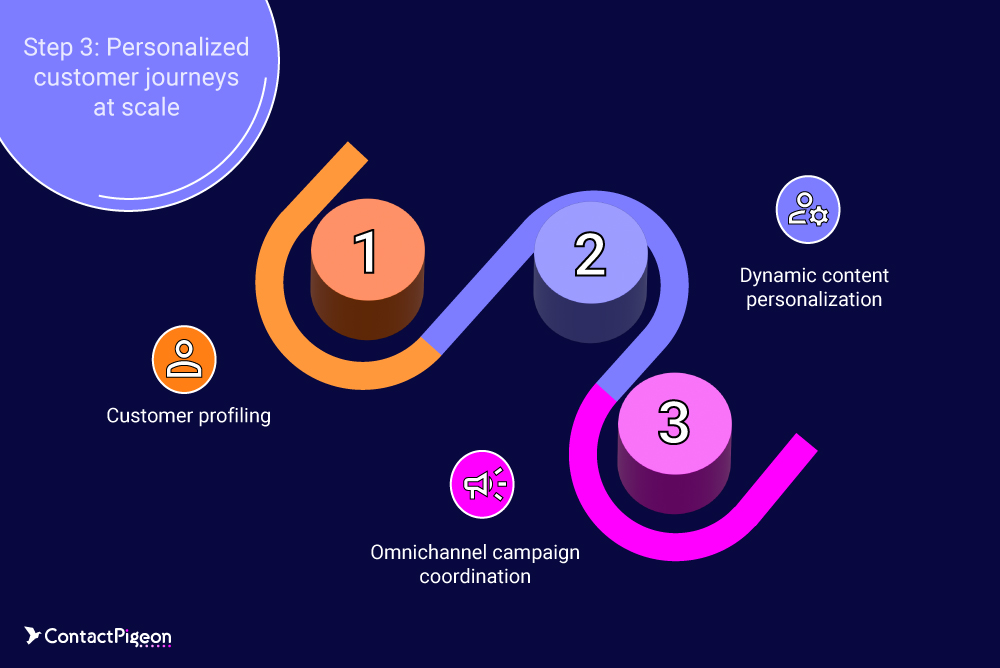
What it is: Personalized customer journeys involve using AI to tailor every interaction a customer has with a brand across multiple channels, based on their unique preferences, behavior, and purchase history. This enhances engagement and significantly boosts conversion rates during the high-stakes BFCM period.
- Customer profiling: Leverage AI to collect and analyze data from every customer touchpoint—email, social media, in-store interactions, and more—to create a unified customer profile.
- Example: A customer who frequently browses tech gadgets receives targeted offers and recommendations for Black Friday tech deals across all their preferred channels.
- Dynamic content personalization: Use AI to dynamically adjust content on websites, emails, and apps based on real-time customer actions and preferences.
- Example: A returning customer sees a personalized homepage with Black Friday discounts on items they’ve shown interest in previously.
- Omnichannel campaign coordination: Coordinate AI-driven campaigns across all channels to ensure a consistent, personalized experience regardless of where the customer engages.
- Example: A customer who abandons their cart online receives a follow-up SMS with an exclusive Black Friday discount, pushing them to complete the purchase.
Opinion leaders to follow:
- Bernard Marr: A leading voice in AI and big data applications for business.
- Hilary Mason: Renowned for her work on data science and AI for personalized experiences.
Companies to watch:
- Amazon: Masters of AI-powered personalization and customer segmentation.
- Sephora: Innovators in using AI for personalized beauty recommendations.
How a retail CDP can assist with Black Friday personalization: A retail CDP like ContactPigeon aggregates data from various sources, enabling precise customer segmentation. This allows retailers to deliver highly targeted and personalized marketing campaigns during BFCM, significantly improving engagement and conversion rates. According to a study by Epsilon, personalized emails can generate up to 6x higher transaction rates, crucial during BFCM.
Step 4: Enhanced customer service with BFCM-themed AI chatbots
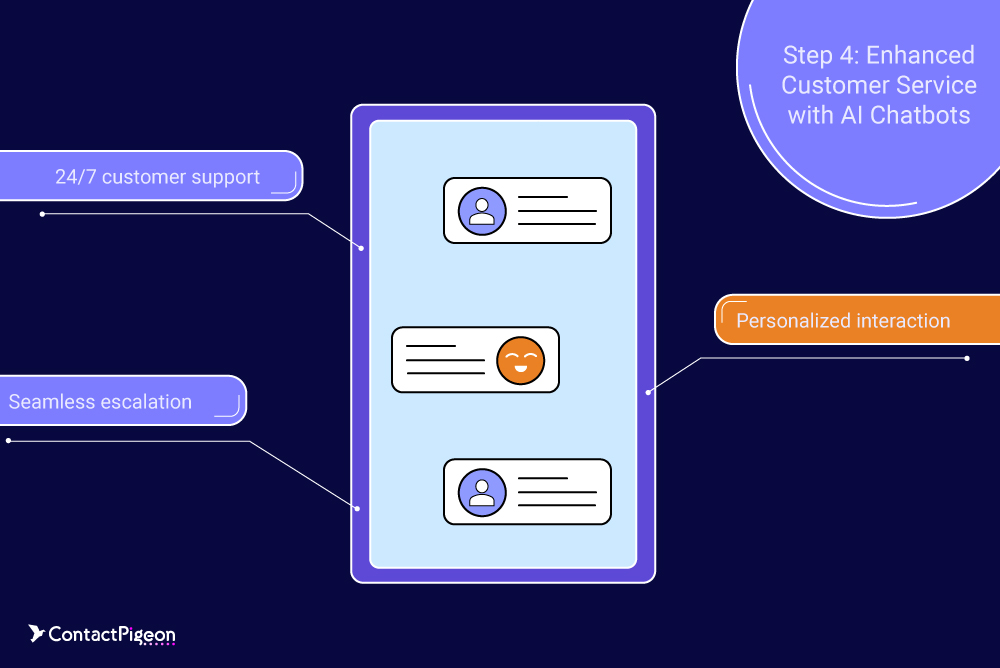
What it is: AI chatbots are automated systems that utilize natural language processing (NLP) to interact with customers in real time, handling large volumes of inquiries efficiently during the BFCM period, and ensuring timely and accurate responses.
- 24/7 customer support: Deploy AI chatbots across your website, mobile app, and social media channels to provide instant customer support throughout BFCM.
- Example: A chatbot assists a customer in tracking their Black Friday order or finding product information, reducing the load on human agents.
- Personalized interactions: Leverage data from customer interactions to personalize responses, making the chatbot more effective and engaging.
- Example: A chatbot suggests relevant products based on the customer’s previous purchase history or browsing behavior.
- Seamless escalation: Ensure the chatbot can seamlessly transfer complex inquiries to human agents when needed, maintaining a high standard of customer service.
- Example: A customer with a billing issue is quickly transferred to a live agent after the chatbot collects basic information.
Opinion leaders to follow:
- Paul Roetzer: Founder of the Marketing AI Institute, a thought leader on AI in customer service.
- Blake Morgan: Author and futurist focused on customer experience and AI’s role in it.
Companies to watch:
- H&M: Utilizes AI chatbots to enhance customer service during peak shopping seasons.
- KLM Royal Dutch Airlines: Innovators in AI-driven customer service through social media channels.
How a retail CDP can assist with Black Friday Customer Service: By integrating with AI chatbots, a retail CDP provides access to unified customer profiles in real time. This allows chatbots to deliver highly personalized service, using past interactions to anticipate customer needs and enhance their experience during BFCM.
Step 5: AI-driven omnichannel BFCM marketing automation
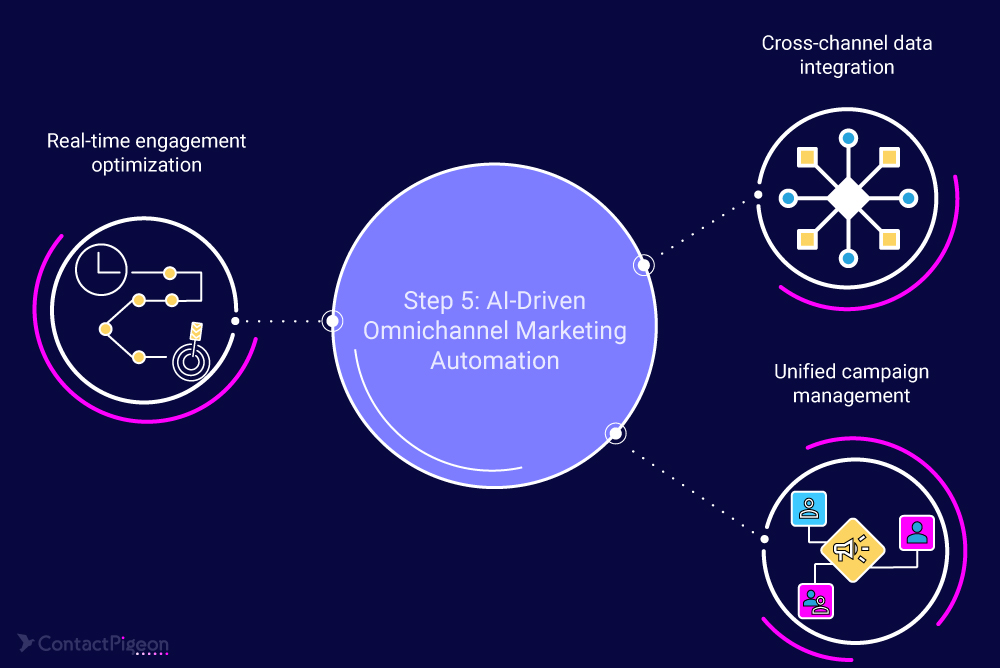
What it is: AI-driven omnichannel marketing automation uses AI to create, coordinate, and deliver marketing messages across multiple channels, ensuring consistency and personalization throughout the customer journey, especially during BFCM.
- Unified campaign management: Use AI to manage and synchronize marketing campaigns across all channels, ensuring that messaging is consistent and personalized at every touchpoint.
- Example: A customer receives a cohesive Black Friday offer via email, social media, and SMS, tailored to their preferences and past behavior.
- Real-time engagement optimization: AI analyzes customer behavior in real time, adjusting campaigns to maximize engagement and conversion rates during BFCM.
- Example: If a customer interacts with an email but doesn’t click through, AI triggers a personalized follow-up SMS to reignite interest.
- Cross-channel data integration: Integrate data from all marketing channels to provide AI with the insights needed to optimize campaigns continuously.
- Example: Data from social media interactions influences email content, creating a more targeted Black Friday offer.
Opinion leaders to follow:
- Katie King: Author and speaker on AI’s transformative role in marketing.
- Tom Davenport: Expert in business analytics and AI-driven marketing strategies.
Companies to watch:
- Nike: Leaders in leveraging AI for personalized omnichannel marketing.
- Starbucks: Known for their AI-driven loyalty programs and marketing initiatives.
How a retail CDP can assist with omnichannel marketing during BFCM: A retail CDP consolidates data from all customer interactions, enabling AI to create and deliver cohesive omnichannel marketing campaigns. This ensures that every BFCM message is consistent, personalized, and optimized for each customer, significantly enhancing engagement and sales.
Step 6: Real-time BFCM decision-making with AI
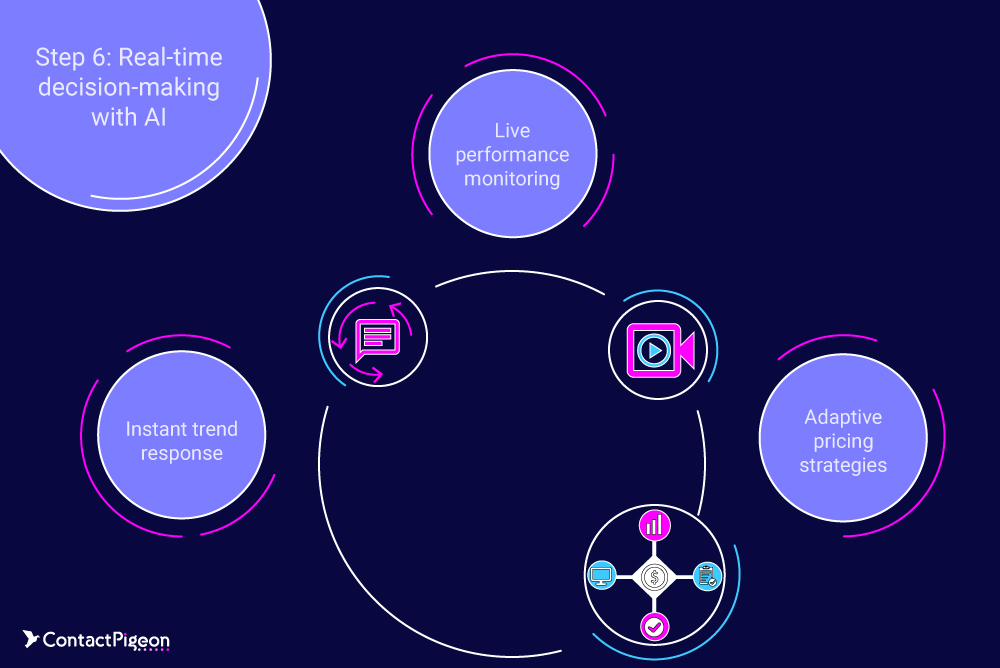
What it is: Real-time decision-making involves using AI to analyze data instantly, allowing retailers to make quick, informed adjustments to their strategies during BFCM. This agility is crucial for staying competitive and maximizing opportunities in a fast-paced environment.
- Live performance monitoring: Implement AI tools that track and analyze campaign performance in real time, allowing you to make instant adjustments.
- Example: If a Black Friday email campaign is underperforming, AI can reallocate resources to more effective channels on the fly.
- Adaptive pricing strategies: Use AI to adjust pricing dynamically based on real-time market conditions and competitor activity, ensuring optimal pricing throughout BFCM.
- Example: AI reduces prices in response to a competitor’s Black Friday discount, keeping your offers competitive.
- Instant trend response: AI can identify emerging trends on social media or within your sales data, prompting immediate action to capitalize on these trends.
- Example: Launch a flash sale on trending products identified by AI during Black Friday.
Opinion leaders to follow:
- Demis Hassabis: Co-founder of DeepMind, leading advancements in AI-driven decision-making.
- Fei-Fei Li: A pioneer in AI research with a focus on real-time data analysis.
Companies to watch:
- Alibaba: Masters of real-time AI-driven decision-making during major sales events.
- Best Buy: Known for their effective use of real-time data analytics to optimize BFCM strategies.
How a retail CDP can assist with real-time decision-making during BFCM: A retail CDP processes data in real-time, providing the insights needed for immediate decision-making during BFCM. Whether it’s reallocating marketing budgets or adjusting pricing strategies, a CDP ensures that retailers can respond to market changes instantly, maximizing their competitive edge during this critical period.
Step 7: AI-enhanced customer retention strategies post-BFCM
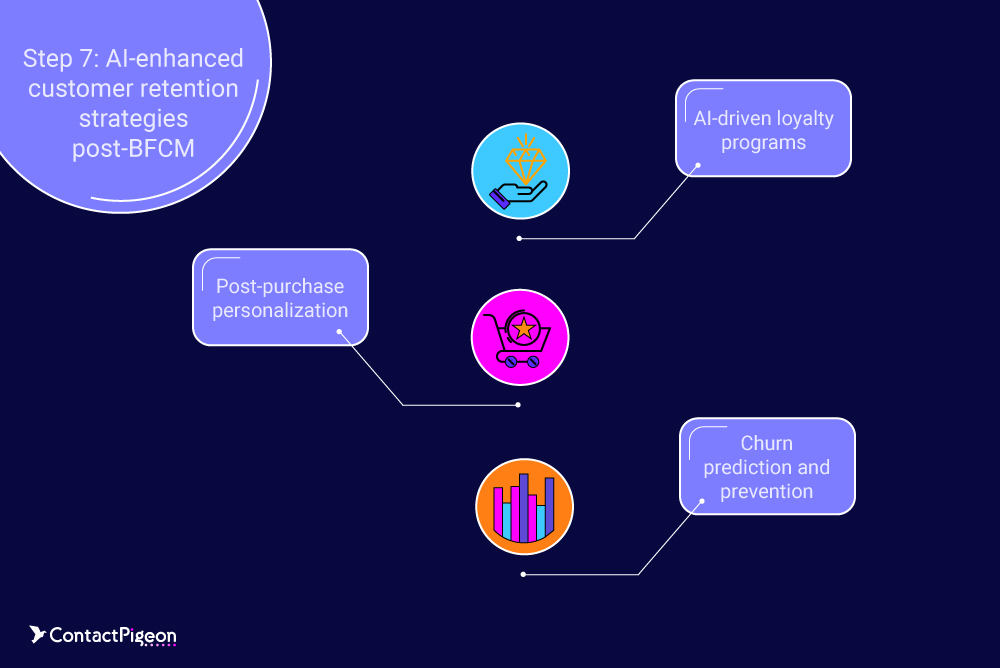
What it is: AI-enhanced customer retention strategies involve using AI to maintain engagement with customers acquired during BFCM, converting one-time buyers into loyal, repeat customers. This approach extends the value generated from BFCM well beyond the initial sales spike.
- Post-purchase personalization: Leverage AI to send personalized follow-up communications post-BFCM, such as product recommendations based on past purchases or personalized thank-you messages.
- Example: A customer who bought a coffee maker on Black Friday receives an email with discounts on coffee beans and accessories.
- AI-driven loyalty programs: Use AI to create and manage loyalty programs that reward customers for continued engagement after BFCM. AI can personalize rewards based on customer preferences, increasing program participation.
- Example: A customer who makes frequent purchases receives customized offers, such as exclusive early access to future sales.
- Churn prediction and prevention: AI analyzes customer behavior to identify patterns that indicate potential churn and triggers retention tactics, such as targeted offers or personalized re-engagement campaigns.
- Example: A customer who hasn’t purchased since Black Friday receives a personalized email with a discount on products similar to their previous purchases.
Opinion leaders to follow:
- Brian Balfour: Growth strategist and expert in customer retention.
- Joanna Lord: Marketing leader with a focus on customer retention and loyalty.
Companies to watch:
- Stitch Fix: Innovators in AI-driven personalization and customer retention.
- Chewy: Known for their exceptional post-purchase customer engagement strategies.
How a retail CDP can assist with post-BFCM customer retention: A retail CDP enables detailed segmentation of customers based on their BFCM behavior, allowing for highly personalized retention campaigns. By understanding who your most valuable customers are and what drives their loyalty, you can extend the benefits of BFCM through targeted re-engagement efforts.
Step 8: AI-optimized customer experience (CX) throughout the BFCM buying journey
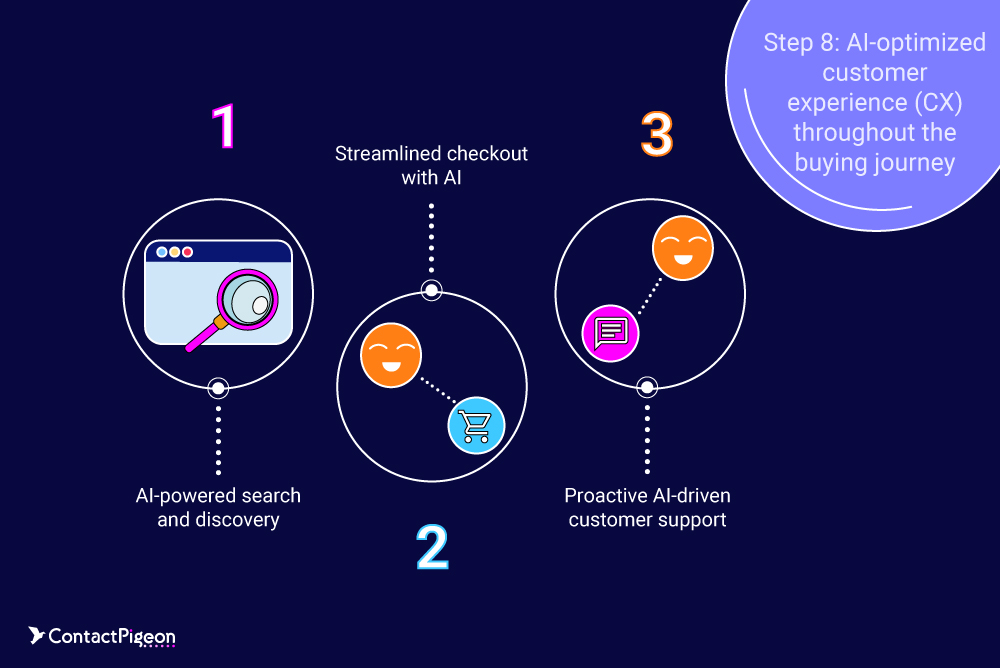
What it is: AI-optimized customer experience (CX) refers to using AI technologies to enhance every aspect of the customer’s buying journey, from initial discovery to post-purchase support. This ensures a seamless, engaging experience that encourages higher conversions and customer satisfaction during BFCM.
- AI-powered search and discovery: Integrate AI into your site’s search functionality to provide more accurate and personalized product recommendations.
- Example: A customer searching for “smartphones” on your website receives AI-driven suggestions based on browsing history, budget, and preferred brands.
- Streamlined checkout with AI: Use AI to simplify the checkout process by offering personalized payment options, autofill capabilities, and real-time fraud detection, reducing cart abandonment rates.
- Example: During Black Friday, customers see their preferred payment method highlighted and benefit from AI-driven real-time credit approvals, leading to faster, hassle-free checkouts.
- Proactive AI-driven customer support: Implement AI-driven customer support tools that proactively address potential issues during the shopping journey, such as automated FAQs, real-time order updates, or personalized product care tips.
- Example: A customer about to abandon their cart receives an AI-generated message offering assistance or a special discount to complete the purchase.
Opinion leaders to follow:
- Colin Shaw: Influencer and author focusing on CX.
- Annette Franz: CX thought leader and author with insights on AI’s impact on customer satisfaction.
Companies to watch:
- Apple: Renowned for their seamless, AI-enhanced customer experiences both online and in-store.
- Zappos: Leaders in using AI to deliver superior customer service and experiences.
How a retail CDP can assist with optimized customer experience during BFCM: A retail CDP collects and integrates data across all customer touchpoints, allowing AI to create a cohesive, personalized experience throughout the buying journey. By ensuring every interaction is tailored to the customer’s preferences and needs, you can drive higher satisfaction and repeat purchases during and after BFCM.
20 advanced customer data rates and metrics to track during a BFCM campaign
- Customer acquisition cost (CAC): Measures the total cost required to acquire a new customer, including marketing and sales expenses.
- Customer lifetime value (CLV): Estimates the total revenue a business can expect from a single customer account throughout their relationship.
- Conversion rate: The percentage of website visitors who complete a desired action, such as making a purchase or signing up for a newsletter.
- Churn rate: The percentage of customers who discontinue using a product or service within a specified period.
- Retention rate: The percentage of customers who continue to use a product or service over a given period.
- Net Promoter Score (NPS): Assesses customer loyalty by measuring the likelihood of customers recommending a company’s products or services to others.
- Average order value (AOV): The average amount of money spent by customers per transaction.
- Customer satisfaction score (CSAT): Measures how satisfied customers are with a company’s products or services, typically through surveys.
- Customer effort score (CES): Evaluates how much effort customers need to exert to get an issue resolved or find information.
- First response time: The average time it takes for a customer service team to respond to a customer’s initial inquiry.
- Resolution time: The average time taken to resolve a customer’s issue or query completely.
- Repeat purchase rate: The percentage of customers who make a second purchase after their initial transaction.
- Purchase frequency: The average number of purchases made by a customer within a specific time frame.
- Customer engagement rate: Measures how actively customers interact with a brand across various channels, such as social media, email, and website.
- Customer journey analysis: Tracks the various stages a customer goes through from initial contact to final purchase and beyond.
- Customer segmentation performance: Evaluate the effectiveness of different customer segments in driving sales and engagement.
- Cross-sell and upsell rates: The frequency at which customers purchase additional or more expensive items than originally intended.
- Product return rate: The percentage of products returned by customers after purchase.
- Customer referral rate: The rate at which existing customers refer new customers to the business.
- Customer feedback sentiment analysis: Analyzes customer feedback to determine the overall sentiment (positive, neutral, or negative) towards the brand.
Important notice: Make sure you focus on November’s data during your analysis since you need to focus on BFCM-related consumer behavior.
How ContactPigeon can assist retailers achieve AI-driven BFCM excellence
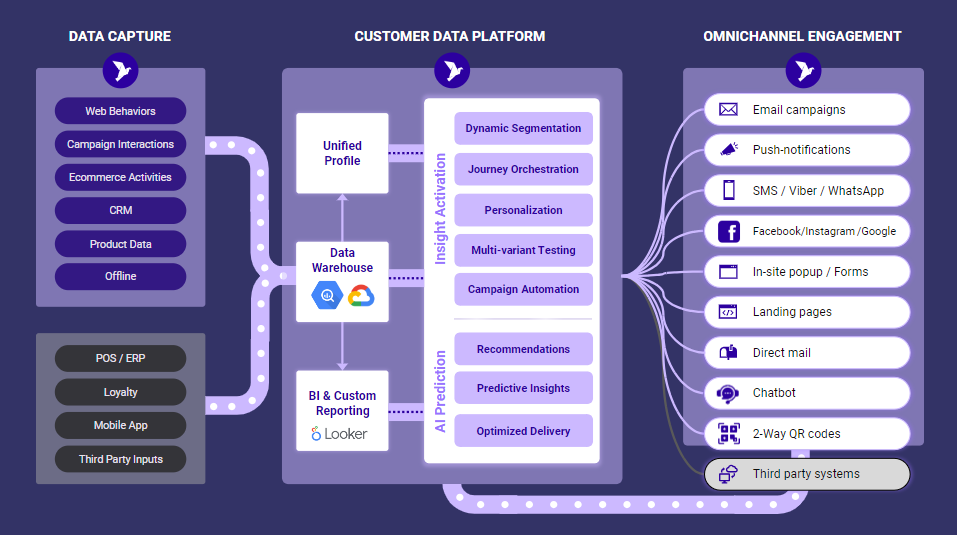
- Personalized omnichannel campaigns: ContactPigeon’s AI-powered platform analyzes customer data from multiple touchpoints to deliver hyper-personalized marketing across email, SMS, and social media. This ensures each Black Friday customer interaction is relevant and timely, significantly increasing engagement and conversion rates during the critical BFCM period.
- Advanced predictive analytics: With its robust CDP capabilities, ContactPigeon uses AI to forecast demand based on historical data and real-time trends. Retailers can optimize inventory levels, reducing stockouts and overstock situations during BFCM, leading to higher sales and improved customer satisfaction.
- Dynamic customer segmentation: ContactPigeon’s CDP enables real-time segmentation of customers based on behavior and preferences. Retailers can tailor BFCM offers and communications to specific segments, maximizing relevance and effectiveness, which leads to better targeting and higher ROI.
- Automated marketing triggers: ContactPigeon automates marketing triggers, such as personalized follow-ups or abandoned cart reminders, based on AI-driven customer insights. This ensures no sales opportunity is missed during BFCM, optimizing the customer journey and boosting conversion rates.
- Comprehensive performance analytics: The platform provides real-time reporting and analytics, allowing retailers to monitor BFCM campaign performance and make instant adjustments. This ensures marketing and sales efforts are optimized throughout the BFCM period, leading to higher efficiency and greater revenue.
AI and BFCM: The holy grail for retailers?
To wrap up, embracing AI is no longer optional—it’s the strategic differentiator that will drive sustained growth, customer loyalty, and a definitive edge over the competition in the ever-evolving retail landscape. As Black Friday and Cyber Monday approach, retail businesses should audit their AI-readiness to effectively meet this year’s BFCM business goals. ContactPigeon, one of the leading retail customer engagement platforms in Europe, can assist your brand. Contact us to optimize your BFCM strategy now at 1-800-490-1732, email us at sales@contactpigeon.com, or book an online demo instantly.

Let’s Help You Scale Up

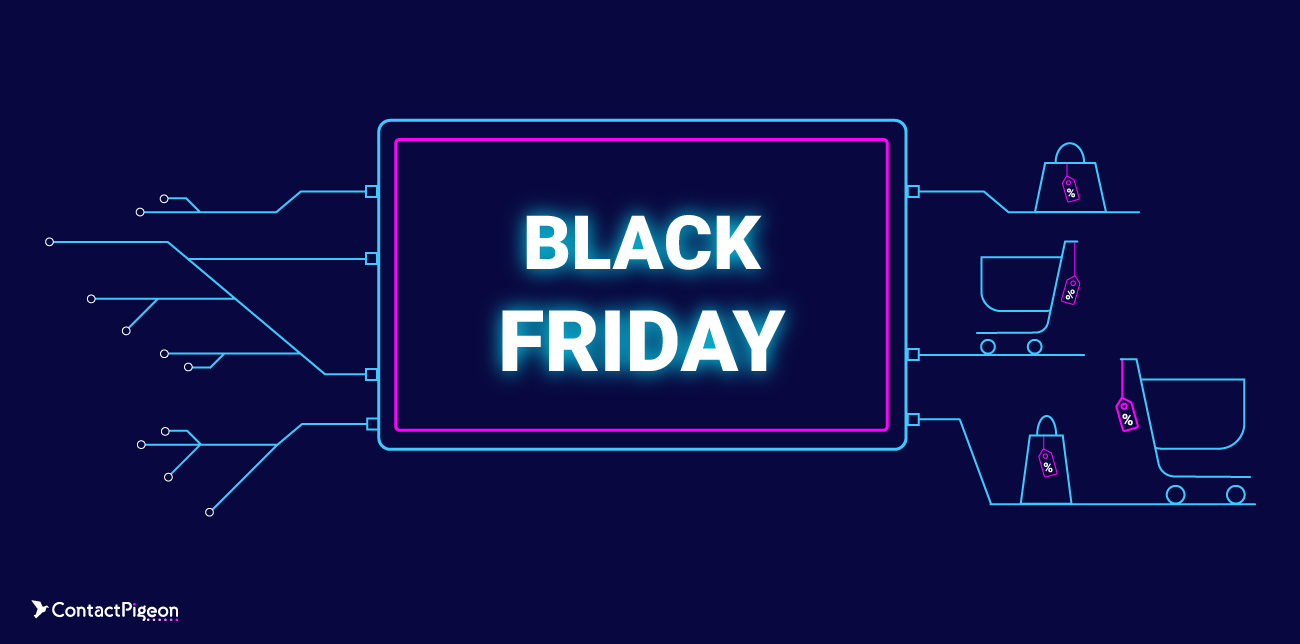

![Benchmarking Growth Strategies of Top Fashion Retailers [Study]](https://blog.contactpigeon.com/wp-content/uploads/2025/11/top-fashion-retailers.jpg)